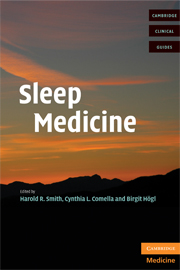Introduction: the basic neurology of sleep
from SECTION 1 - NORMAL SLEEP
Published online by Cambridge University Press: 08 August 2009
Summary
Overview
Sleep is not an inactive state.
Dating back to early modern classifications of sleep based on electrophysiological measurements, the inherent activities of various neural substrates in sleep have been readily recognized.
Normal sleep has been classified as having two characteristic divisions: non-rapid eye movement (NREM) and rapid eye movement (REM) sleep. These sleep states are defined by neurophysiological parameters of electroencephalogram (EEG), electrooculogram (EOG), and surface electromyogram (EMG), as detailed by Dr. Billiard in the following chapter. These characteristics clearly distinguish the NREM and REM sleep states from the wakefulness state.
Behaviorally, sleep is a reversible state characterized by perceptual disengagement and apparent unresponsiveness to the environment with closed eyes, reduced movements, and recumbency. Early behaviorally based studies revealed that even in those with unequivocal electrophysiologic correlates of being asleep, arousal to one's own name and responsiveness to other auditory stimuli persist.
Additionally, the understanding that continues to evolve of the neurophysiology and neurochemistry of normal sleep suggests that many of the neurologic substrates involved are by no means passive, but rather very active in sleep. An example is the increase in cerebral blood flow that occurs in normal sleep. Both animal and human studies have shown that cerebral blood flow in NREM sleep may increase up to 25% greater than in wakefulness, and up to 80% greater in REM sleep. These changes in cerebral blood flow, at least in part, correlate with concomitant increased brain oxygen metabolism in sleep.
- Type
- Chapter
- Information
- Sleep Medicine , pp. 1 - 8Publisher: Cambridge University PressPrint publication year: 2008
References
- 1
- Cited by



